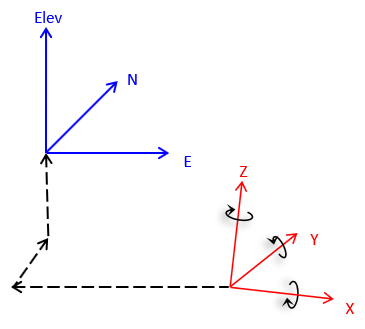6. Two-Dimensions vs Three-Dimensions
While the discussion here is limited to horizontal (two dimensional) coordinate systems, it is relatively easy to extend this into the third dimension by incorporating elevations or Z coordinates. An additional translation parameter would be needed for the elevation component, TElev.
The rotation angle, ρ, for a two dimensional transformation is a horizontal angle rotated about the vertical, or Z, axis. In a three dimensional transformation there would three rotation angles, one about each axis. Figure J-25 shows X-Y-Z as the From system and E-N-Elev as the To system. There are three rotations and three translations. How about scale?
|
|
|
Figure J-25 |
Scale could again be Unitary, Uniform, or Differential. In the latter case, there would be three scale factors.
The total number of parameters in a three dimensional transformation could be:
- Six: Three translations, three rotations, 1:1 scale
- Seven: Three translations, three rotations, uniform scale
- Eight: Three translations, three rotations, one scale for horizontal, one scale for vertical
- Nine: Three translations, three rotations, three scales
The eight-parameter transformation could be used where there is a quality difference between horizontal and vertical positions in one system or the other.
